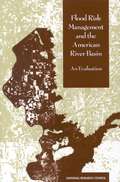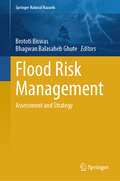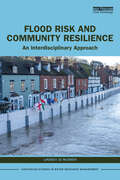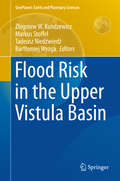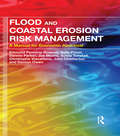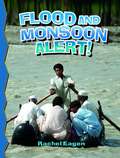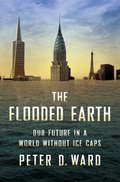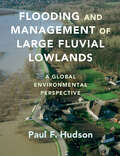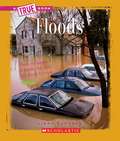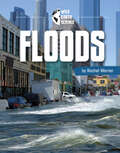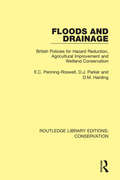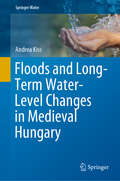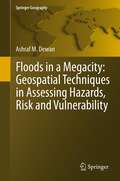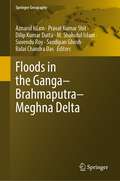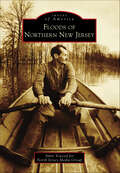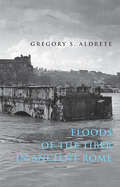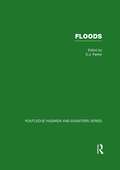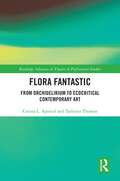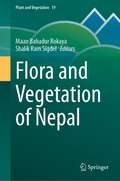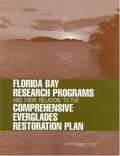- Table View
- List View
Flood Risk Management and the American River Basin: An Evaluation
by Committee on Flood Control Alternatives in the American River BasinThis book reviews the U.S. Army Corps of Engineers' (USACE) investigations of flood control options for the American River basin and evaluates flood control feasibility studies for the watershed, with attention to the contingency assumptions, hydrologic methods, and other analyses supporting the flood control options.This book provides detailed comments on many technical issues, including a careful review of the 1991 National Research Council report American River Watershed Investigation, and looks beyond the Sacramento case to broader questions about the nation's approach to flood risk management. It discusses how to utilize information available about flood hazard reduction alternatives for the American River basin, the potential benefits provided by various alternatives, the impacts of alternatives on environmental resources and ecosystems, and the trade-offs inherent in any choice among alternatives which does not lie in the realm of scientists and engineers, but in the arena of public decisionmaking.
Flood Risk Management: Assessment and Strategy (Springer Natural Hazards)
by Brototi Biswas Bhagwan Balasaheb GhuteThis book examines the nature of flood in different landscapes and the various factors that contribute to flooding in different areas. It identifies flood risk zones in different terrain types and provides valuable insights into the anthropogenic, geographical, hydro-geological, and geomorphological aspects of flood-prone areas to achieve sustainable risk management. The book also explores the impact of avalanches, global warming, and flash floods in different settings where such types of flooding have become more common. In addition, the volume provides case studies to evaluate the impact of flooding in both natural and man-made environments. To better understand and manage floods, the book combines advanced geospatial tools and techniques with indigenous knowledge. Using machine learning and multiple-criteria decision analysis, the book provides an amalgamation of technology and indigenous knowledge to assess flood susceptibility. The book also includes strategies to manage flood risks and case studies that demonstrate best practices in flood risk management. The volume is a valuable resource for researchers, students, and policy makers to understand the causes of floods and their socio-economic impact in different areas.
Flood Risk and Community Resilience: An Interdisciplinary Approach (Earthscan Studies in Water Resource Management)
by Lindsey Jo McEwenThis book details the impact of flooding on our environment, and the ways in which communities, and those that work with them, can act to manage the associated risks.Flooding is an increasingly significant environmental hazard which inflicts major costs to the economies and livelihoods of developed countries. This book explores how local communities can identify, manage, and adapt to the ever-increasing damage flooding causes. Focusing on the future role of local communities, the benefits and challenges of their involvement, and the potential areas of transformation, this book provides insights into the efficacy of interdisciplinary and transdisciplinary working. Alongside research into similar environmental hazards, this book also draws upon the author’s own knowledge of flood risk management in distinctive non-contiguous interdisciplinary settings. The chapters draw together a different and distinctive set of interdisciplinary themes in flood risk management and social resilience. In doing so, it strives to communicate the different ways of thinking that can usefully contribute to flood risk management.This book would be ideal for those researching flood risk management, alongside scholars and non-scholars alike who are interested in finding ways of adapting to environmental hazards working with local communities.
Flood Risk in the Upper Vistula Basin
by Markus Stoffel Zbigniew W. Kundzewicz Tadeusz Niedźwiedź Bartłomiej WyżgaThis pioneering book addresses the entirety of river flooding issues in the Upper Vistula Basin, where considerable flood generation potential exists. It analyses the factors influencing flood risk, investigates variations in observation records and discusses projections for the future and adaptation to changing risk. It serves the general interest in understanding the floods that cause massive destruction in Europe, with dozens of fatalities and tremendous material damages. This interdisciplinary book, which covers aspects of climatology, geomorphology, hydrology, and water and flood risk management, unveils the complexity of the current situation. Access to reliable and accurate information can help solve important practical problems related to flood risk reduction strategies, and is at the core of the EU Floods Directive. As such, the book offers a valuable resource for scientists, educators and practitioners involved in water management, natural disaster reduction and adaptation to climate change.
Flood Warning (Let's-Read-and-Find-Out Science 2)
by Katharine KenahRead and find out about the different kinds of floods, how they start, and how to stay safe in this colorfully illustrated nonfiction picture book.You are lying in bed listening to the soft sound of rain. It has been coming down for hours. Now something is changing. The rain sounds harder and louder, and there is water running down the road, which looks like a small river. What is happening? You are hearing and seeing the start of a flood.With colorful illustrations and engaging text, Flood Warning is a fascinating look into a dangerous natural disaster. Featuring rich vocabulary bolded throughout the text, this book also includes a find out more section with instructions on how to make a rain gauge and an infographic about saving water at home. Both the text and the artwork were vetted for accuracy by Dr. Christopher Kenah, Geologist, Division of Drinking and Ground Waters, Ohio Environmental Protection Agency.This is a clear and appealing science book for early elementary age kids, both at home and in the classroom. It's a Level 2 Let's-Read-and-Find-Out, which means the book explores more challenging concepts for children in the primary grades. The 100+ titles in this leading nonfiction series are:hands-on and visualacclaimed and trustedgreat for classroomsTop 10 reasons to love LRFOs:Entertain and educate at the same timeHave appealing, child-centered topicsDevelopmentally appropriate for emerging readersFocused; answering questions instead of using survey approachEmploy engaging picture book quality illustrationsUse simple charts and graphics to improve visual literacy skillsFeature hands-on activities to engage young scientistsMeet national science education standardsWritten/illustrated by award-winning authors/illustrators & vetted by an expert in the fieldOver 130 titles in print, meeting a wide range of kids' scientific interestsBooks in this series support the Common Core Learning Standards, Next Generation Science Standards, and the Science, Technology, Engineering, and Math (STEM) standards. Let's-Read-and-Find-Out is the winner of the American Association for the Advancement of Science/Subaru Science Books & Films Prize for Outstanding Science Series.
Flood and Coastal Erosion Risk Management: A Manual for Economic Appraisal
by Edmund Penning-Rowsell Sally Priest Dennis Parker Joe Morris Sylvia Tunstall Christophe Viavattene John Chatterton Damon OwenA new ‘Multi-Coloured Manual' This book is a successor to and replacement for the highly respected manual and handbook on the benefits of flood and coastal risk management, produced by the Flood Hazard Research Centre at Middlesex University, UK, with support from Defra and the Environment Agency. It builds upon a previous book known as the "multi-coloured manual" (2005), which itself was a synthesis of the blue (1977), red (1987) and yellow manuals (1992). As such it expands and updates this work, to provide a manual of assessment techniques of flood risk management benefits, indirect benefits, and coastal erosion risk management benefits. It has three key aims. First it provides methods and data which can be used for the practical assessment of schemes and policies. Secondly it describes new research to update the data and improve techniques. Thirdly it explains the limitations and complications of Benefit-Cost Analysis, to guide decision-making on investment in river and coastal risk management schemes.
Flood and Monsoon Alert! (Disaster Alert!)
by Rachel EagenIn light of the devastating floods in 2010 in Pakistan, Brazil, the United States, and China, this informative book has been newly revised. Floods result from heavy rains and high winds that cause an overflow in water sources such as lakes, rivers, and oceans. Discover how monsoons differ from other storms and how people cope with their devastation.
Flooded Earth: Our Future In a World Without Ice Caps
by Peter D. WardSea level rise will happen no matter what we do. Even if we stopped all carbon dioxide emissions today, the seas would rise one meter by 2050 and three meters by 2100. This--not drought, species extinction, or excessive heat waves--will be the most catastrophic effect of global warming. And it won’t simply redraw our coastlines--agriculture, electrical and fiber optic systems, and shipping will be changed forever. As icebound regions melt, new sources of oil, gas, minerals, and arable land will be revealed, as will fierce geopolitical battles over who owns the rights to them. In The Flooded Earth, species extinction expert Peter Ward describes in intricate detail what our world will look like in 2050, 2100, 2300, and beyond--a blueprint for a foreseeable future. Ward also explains what politicians and policymakers around the world should be doing now to head off the worst consequences of an inevitable transformation.
Flooding and Management of Large Fluvial Lowlands: A Global Environmental Perspective
by Paul F. HudsonPressure on large fluvial lowlands has increased tremendously during the past twenty years because of flood control, urbanization, and increased dependence upon floodplains and deltas for food production. This book examines human impacts on lowland rivers, and discusses how these changes affect different types of riverine environments and flood processes. Surveying a global range of large rivers, it provides a primary focus on the lower Rhine River in the Netherlands and the Lower Mississippi River in Louisiana. A particular focus of the book is on geo-engineering, which is described in a straight-forward writing style that is accessible to a broad audience of advanced students, researchers, and practitioners in global environmental change, fluvial geomorphology and sedimentology, and flood and water management.
Floods
by Libby KoponenWhat makes the earth quake, rivers flood, and volcanoes blow their tops? How do natural forces become natural disasters? Buckle your seatbelts and get ready for a bumpy ride to the center of the earth for a look at some of the wildest phenomena in the history of earth science!
Floods (Dangerous Weather)
by Michael AllabyFrom the Book jacket: Floods have caused more damage and killed more people than any other form of dangerous weather. From the life and travels of a single molecule of water to the destructive power of a flash flood, author Michael Allaby reveals the wonder and occasional terror unleashed by water in motion. Floods describes every type of flood condition, how humankind has learned to limit some of the damage floods can cause, great floods of the past, how some floods are good, and how readers can protect themselves and others from danger during floods. The Dangerous Weather series imparts fundamental weather science to readers through author Michael Allaby's vivid descriptions of extreme weather systems. The series focuses on the five most dangerous kinds of weather activity; diagrams related meteorological, climatological, and environmental basics in clear, compelling language; chronicles the history of each form of dangerous weather; and offers safety precautions for extreme weather conditions. Fully illustrated and indexed, the Dangerous Weather series is an invaluable tool for student research. Other volumes include: hurricanes tornadoes blizzards droughts A chronology of weather Michael Allaby is the author of more than 40 books, mainly on science, natural history, and environmental topics. A few of his previous works include Basics of Environmental Science, How It Works: The Environment, and The Concise Oxford Dictionary of Ecology. He is a member of the New York Academy of Sciences, among other professional affiliations.
Floods (Wild Earth Science)
by Rachel WernerPeople, plants, and animals all need rain. But the ground can take in only so much. Too much, and the land will flood. Farms and cities can be damaged. People must move to dry ground until, slowly, the water soaks into the earth. Learn about floods, what we can do, and how to stay safe.
Floods and Drainage: British Policies for Hazard Reduction, Agricultural Improvement and Wetland Conservation (Routledge Library Editions: Conservation #5)
by E.C. Penning-Rowsell D. J. Parker D.M. HardingOriginally published in 1986, Floods and Drainage advanced hazard – response theory as developed mainly by the White/Burton/Kates school of researchers in North America. Based on fifteen years of research, the book rejects conventional theory’s emphasis on personal response to hazardous environments, suggesting that this seriously detracts from the institutional and political forces that are so important in the analysis of hazard responses and policies. The book also seeks to provide material of practical relevance to environmental managers and engineers, rather than to present just research results.
Floods and Long-Term Water-Level Changes in Medieval Hungary (Springer Water)
by Andrea KissThe book provides an overview of the floods and major hydrological changes that occurred in the medieval Hungarian kingdom (covering the majority of the Carpathian Basin) between 1000 and 1500 AD. The analysis was based on contemporary documentary evidence presented for the first time and the results of archaeological and scientific investigations. Beyond the evidence on individual flood events, the book includes a comprehensive overview of short-, medium-, and long-term changes detected in a hydrologically sensitive environment during the transition period between the Medieval Warm Period and the Little Ice Age. It also discusses the possible causes (including climate and human intervention) and the consequences for the physical and human environment, namely the related hydro-morphological changes, short- and long-term social response, and human perception issues.
Floods in a Changing Climate
by P. P. Mujumdar D. Nagesh KumarVarious modeling methodologies are available to aid planning and operational decision making: this book synthesises these, with an emphasis on methodologies applicable in data scarce regions, such as developing countries. Problems included in each chapter, and supported by links to available online data sets and modeling tools, engage the reader with practical applications of the models. Academic researchers in the fields of hydrology, climate change, and environmental science and hazards, and professionals and policy-makers working in hazard mitigation, remote sensing and hydrological engineering will find this an invaluable resource. This volume is the second in a collection of four books on flood disaster management theory and practice within the context of anthropogenic climate change. The others are: Floods in a Changing Climate: Extreme Precipitation by Ramesh Teegavarapu, Floods in a Changing Climate: Inundation Modelling by Giuliano Di Baldassarre and Floods in a Changing Climate: Risk Management by Slodoban Simonović.
Floods in a Megacity
by Ashraf DewanFlooding is one of the most devastating natural hazards in the world. Available records suggest that both flood frequency and severity are on the rise and this is likely to worsen in the context of climate change. As population, infrastructure and poverty grow rapidly in developing countries, particularly in urban agglomerations of 10 million people or more, floods could cause widespread devastation, economic damage and loss of life. Assessment of vulnerability and risk from naturally occurring phenomena is therefore imperative in order to achieve urban sustainability. This book uses geospatial techniques to evaluate hazards, risk and vulnerability at a metropolitan scale in a data-scarce country. An empirical study was performed using remote sensing, GIS and census data. This research offers a new approach to mapping population, infrastructures and communities at risk which can greatly contribute to the deeper understanding of flood disasters in a rapidly expanding megacity. Examples shown in this book are from Dhaka Megacity, however, the techniques and methods can easily be implemented in medium to large cities of similar characteristics. The book is essential reading for hazard researchers, geospatial scientists, disaster management professionals, geographers, urban planners, and social scientists. Ashraf M. Dewan is currently a Lecturer in the Department of Spatial Sciences at Curtin University, Western Australia (on leave from his substantive position as Associate Professor in the Geography & Environment Department at the University of Dhaka, Bangladesh).
Floods in the Ganga–Brahmaputra–Meghna Delta (Springer Geography)
by Balai Chandra Das Sandipan Ghosh Aznarul Islam Pravat Kumar Shit Suvendu Roy Dilip Kumar Datta M. Shahidul IslamThis volume covers the floods of the major rivers of the Ganga-Brahmaputra-Meghna (GBM) Delta, and storm surge related coastal floods in these regions. The book is dedicated to addressing floods from an integrated physical-social perspective to provide students and researchers with a holistic understanding of floods in terms of both human and geomorphological aspects. The systematic coverage of all the major rivers and coastal areas in the GBM delta and surrounding regions will foster a clear comprehension of this dense reservoir of population, where thousands of people are impacted every year due to flood hazards and agricultural destabilization. This comprehensive treatment of flood issues in the region covers flash floods, fluvial floods, fluvio-tidal floods, and coastal floods, and outlines flood management strategies to maintain ecological integrity and environmental stability, and prevent harmful impacts of future floods. The book is intended for students and researchers in earth and environmental sciences, especially geomorphology, hydrology, geography, geology, natural resources management, and regional planning.
Floods of Northern New Jersey (Images of America)
by North Jersey Media Group Amre YoussefSituated between winding rivers and prone to turbulent storms, northern New Jersey has had an extensive and tumultuous history of flooding. The most severe flood occurred in 1903 when three days of nonstop rain, averaging 12 inches per day, melted more than 23 inches of snow and ice�inundating the cities of Passaic and Wallington and splitting Paterson in two. Since 1945, more than 60 documented storms have wreaked havoc and shaken the region. In 2011, the second-worst storm in North Jersey�s history, Hurricane Irene, struck with more than 11 inches of rain, displacing 6,000 residents in Paterson alone and hitting Bergen and Passaic Counties with a vengeance. Only one year later, Superstorm Sandy rolled into North Jersey, flooding Moonachie and Little Ferry with surges up to five feet. Floods of Northern New Jersey showcases the rich documentation of flooding through a unique and significant photographic collection.
Floods of the Tiber in Ancient Rome (Ancient Society and History)
by Gregory S. AldreteWhile the remains of its massive aqueducts serve as tangible reminders of Rome’s efforts to control its supply of drinking water, there are scant physical reminders that other waters sometimes raged out of control. In fact, floods were simply a part of life in ancient Rome, where proximity to the Tiber left a substantial part of the city vulnerable to the river's occasional transgressions. Here, in the first book-length treatment of the impact of floods on an ancient city, Gregory S. Aldrete draws upon a diverse range of scientific and cultural data to develop a rich and detailed account of flooding in Rome throughout the classical period.Aldrete explores in detail the overflowing river’s destructive effects, drawing from ancient and modern written records and literary accounts, analyses of the topography and hydrology of the Tiber drainage basin, visible evidence on surviving structures, and the known engineering methods devised to limit the reach of rising water. He discusses the strategies the Romans employed to alleviate or prevent flooding, their social and religious attitudes toward floods, and how the threat of inundation influenced the development of the city's physical and economic landscapes.
Floods of the Tiber in Ancient Rome (Ancient Society and History)
by Gregory S. AldreteA study of the impact of flooding on the ancient city during the classical period.While the remains of its massive aqueducts serve as tangible reminders of Rome’s efforts to control its supply of drinking water, there are scant physical reminders that other waters sometimes raged out of control. In fact, floods were simply a part of life in ancient Rome, where proximity to the Tiber left a substantial part of the city vulnerable to the river’s occasional transgressions.Here, in the first book-length treatment of the impact of floods on an ancient city, Gregory S. Aldrete draws upon a diverse range of scientific and cultural data to develop a rich and detailed account of flooding in Rome throughout the classical period.Aldrete explores in detail the overflowing river’s destructive effects, drawing from ancient and modern written records and literary accounts, analyses of the topography and hydrology of the Tiber drainage basin, visible evidence on surviving structures, and the known engineering methods devised to limit the reach of rising water. He discusses the strategies the Romans employed to alleviate or prevent flooding, their social and religious attitudes toward floods, and how the threat of inundation influenced the development of the city’s physical and economic landscapes.“Floods of the Tiber in Ancient Rome is that rare thing in scholarship, a work that genuinely fills a gap in the scholarly literature. Professor Aldrete has brilliantly illuminated an aspect of ancient Rome that was ever present to the city’s inhabitants but almost invisible to modern historians.” —Stanley Burstein, history teacher“Raises important questions about the effects of flooding of the Tiber on the city of ancient Rome and its inhabitants and explores why Romans did not take more sweeping steps to reduce, if not eliminate, the dangers of urban flooding. There is no comparable book-length study of this topic, so this work fills a real need. It will be of interest not only to students of ancient history, but to hydrologists and students of urban studies as well. Certainly it will give us classicists much to think about in our assessment of urban life in ancient Rome.” —Harry B. Evans, Fordham University, author of Aqueduct Hunting in the Seventeenth Century
Floods: British Policies For Hazard Reduction, Agricultural Improvement And Wetland Conservation (Routledge Library Editions: Conservation Ser. #5)
by D. J. ParkerFloods occur in most parts of the world and range from being welcomed annual occurrences, to natural disasters which have countless physical and societal impacts. Floods presents the most comprehensive collection to date of new research, providing a rich body of theory and experience and drawing together contributions from over fifty leading international researchers in the field. An extensive range of case-studies covering major floods and regions prone to flooding worldwide are included.
Floods: Extreme Weather (Theme Sets)
by Josie GreenExplains the causes of four different types of weather: droughts, floods, tornadoes, and hurricanes
Flora Fantastic: From Orchidelirium to Ecocritical Contemporary Art (ISSN)
by Corina L. Apostol Tashima ThomasThis book delves deep into colonial botany, utilizing mediums such as historical investigation, cinema, photography, live performance, and installation art.Surveying perspectives from Europe, the U.S., Africa, Southeast Asia, Latin America, and the Caribbean, it positions plants—both native and foreign—as active participants and silent observers in colonial narratives. By viewing through the prism of visual and performance art, this book touches on diverse topics like the economic value of plants, traditional and Western medicine, state‑endorsed scientific endeavors, migration patterns of flora and people, bio‑contact areas, nationalistic views, and botanical diplomacy. It offers fresh insights into colonial botany’s multifaceted history, emphasizing the intricate interplay between Eastern, Western, and Southern nations during the twentieth century and its enduring impact today.Serving as an invaluable addition to the realms of art history, performance studies, botany, visual culture, decolonial initiatives, and environmental politics, this book arrives at a pivotal moment when its insights are most crucial.
Flora and Vegetation of Nepal (Plant and Vegetation #19)
by Maan Bahadur Rokaya Shalik Ram SigdelThis volume highlights the plant life of Nepal, which accounts for 20% of the Himalayan biodiversity. For the first time, this group of authors compile over 200 years’ worth of local botanical research. Due to the high topographical diversity, Nepal has a very unique flora and vegetation. The chapters focus on cryptogams, phanerogams and alien flora. As an added bonus, historical background for native and invasive species, is explained. Aside from botanical knowledge, the authors also shed a light on Nepali geography, soil, climate and land use. To complete the picture, readers will find data on different plants, maps and photographs of unique species. This book is a valuable resource for Botanists and Ecologists, but also for interested travelers who would like to complement their next trek in Nepal.
Florida Bay Research Programs And Their Relation To The Comprehensive Everglades Restoration Plan
by Committee on Restoration of the Greater Everglades EcosystemThe National Academies Press (NAP)--publisher for the National Academies--publishes more than 200 books a year offering the most authoritative views, definitive information, and groundbreaking recommendations on a wide range of topics in science, engineering, and health. Our books are unique in that they are authored by the nation's leading experts in every scientific field.
